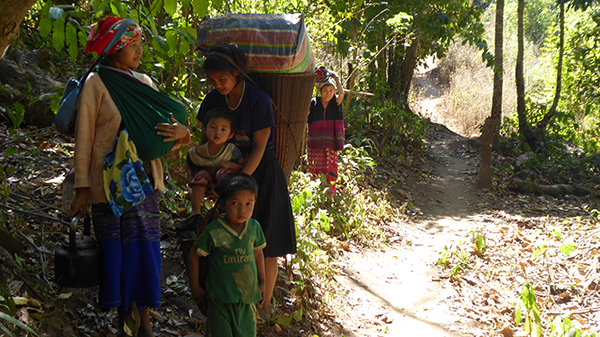Featured Image: Myaing Gyi Ngu IDP camp in Hlaingbwe Township, Karen state, Karen News
In light of June being Refugee Awareness Month with World Refugee Day on June 20th, the US Campaign for Burma would like to highlight the history of refugees and internally displaced peoples in the various states of Burma. Our final installment will cover Karen state, following our previous installments on Mon state, Karenni state, Shan state, Chin state, Arakan state, and Kachin state.
Karen state is in southern Burma, covering areas along the Thai border and Irrawaddy Delta, and consists of over 20 ethnic Karen subgroups. The Karen people are predominantly Buddhists, although small numbers of Christian and Animist ethnic Karen also exist. Fighting between the Karen National Union (KNU), an ethnic armed organization in Karen State, and the Burma Army has been consistent in Karen State for decades and commonly results in indiscriminate attacks against civilians, amongst other human rights violations.

Ethnic Karen have suffered from arson, sexual violence, forced labor, land confiscation and grabbing, and murder, all at the hands of the Burma Army. As recently as June 2020, the Burma Army fired artillery shells into a village in LuThaw Township and injured two civilians. Between April and May 2020, the KNU estimates that the Burma Army’s increased militarization of civilian areas has caused more than 130 villagers to flee their homes. These blatant abuses and exploitation of power have caused thousands from Karen state to flee as refugees or become internally displaced peoples residing in IDP camps or hiding in the nearby jungle. Fighting in 2016 caused thousands of villagers to flee to Myaing Gyi Ngu IDP camp, where more than 5,000 IDPs remain today, unable to obtain food due to the lack of regular donors. IDPs in Aye Linn Mya Shin camp are suffering from shelter damage due to monsoon season and are at risk of being unhoused, in addition to being unable to obtain basic necessities such as food, water, medicine, and clothing.
In January 2019, the UN Special Rapporteur on the situation of human rights in Myanmar stated that there are over 162,000 IDPs in Burma’s Southeast states alone, sheltering primarily in camps or rural areas. Additionally, the UNHCR estimates that there are more than 97,439 refugees, predominantly Karen, living in nine camps on the Thai-Burma border. Despite these staggering numbers that have only grown higher, the Burmese government stated plans to close IDP camps in Arakan, Kachin, Shan, and Karen states, and has suspended aid from organizations assisting the IDPs. Similarly, in 2017, Ei Tu Hta camp in Karen state and refugee camps in Thailand suffered from funding cuts with no accepted appeals for emergency funding. According to Asia Times, the UK Department for International Development cut its backing of The Border Consortium (TBC) by 40%, causing TBC to focus its resources on larger populations in Thai refugee camps and away from Ei Tu Hta camp.

The Burma Army continues to incite violence in Karen state even through a global pandemic – when the KNU set up COVID-19 screening posts in Lu Thaw Township, the Burma Army forced the health workers out and burned the posts that they regarded as a KNU “political tactic.” Villagers on the ground stated that it has always been obvious that the Burma Army acts without the best interests of the people, as shown through the implementation of the Shwe Kokko project, a complex of apartments, casinos, and an airport that would take thousands of acres of indigenous Karen land. This project will not only add to the numbers of forcibly displaced peoples in Karen state but will exploit local communities for the Burmese government’s gain. The most vulnerable populations during the time of COVID-19 are IDPs and refugees, who are unhoused and without reliable resources to prevent the spread of the virus.

It is important to note, however, the internally displaced peoples and refugees need to be at the center of every conversation, not just during a global pandemic. The United States government and the rest of the international community need to place IDP and refugee issues at the forefront of all dialogue surrounding Burma and work to better educate themselves on the needs and plight of these people.
Click here to view a video on human rights and accountability in Southeastern Burma. For more information on conflict and IDPs in Karen State, click here to access USCB’s Crowd Map and read articles from each state.